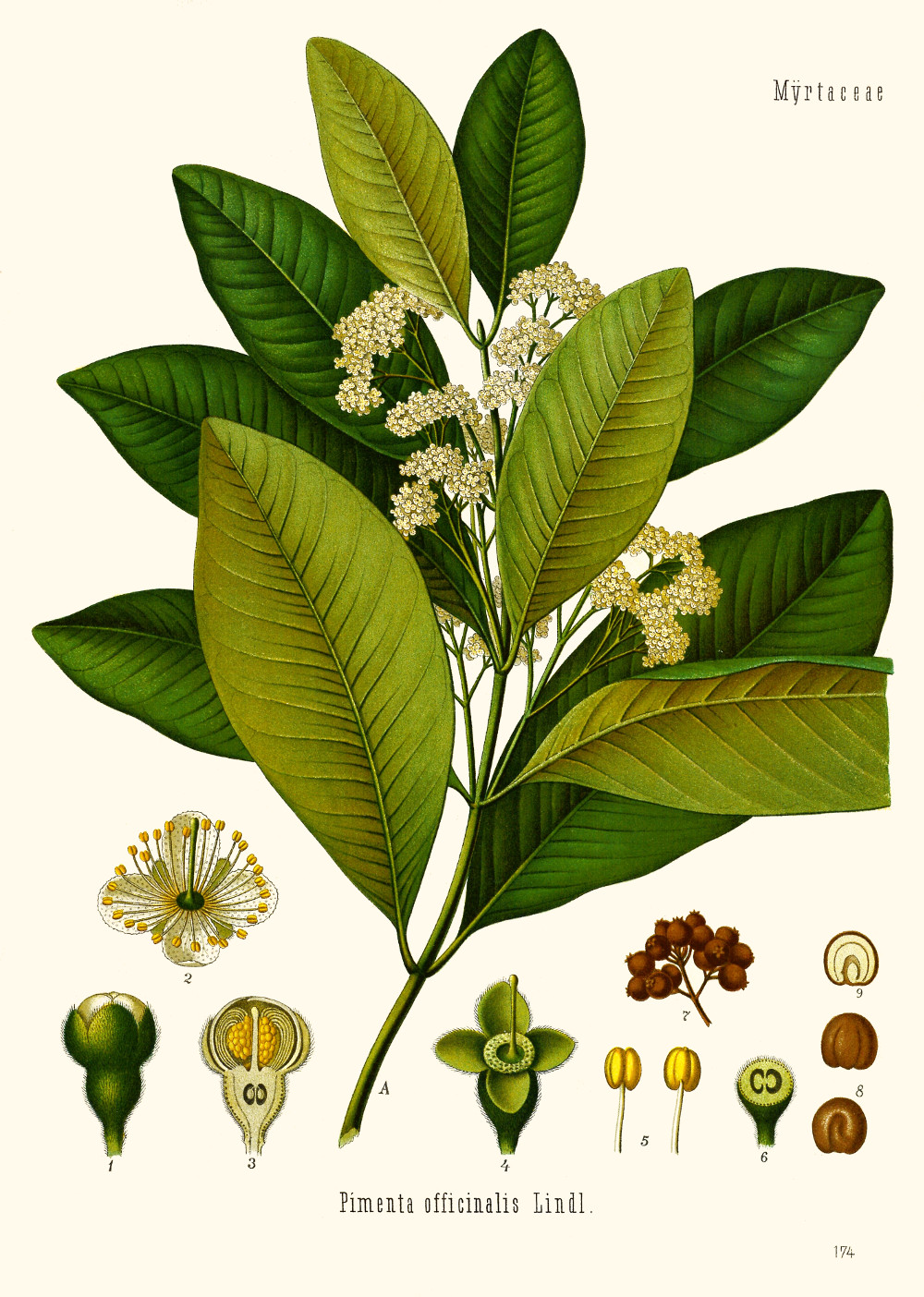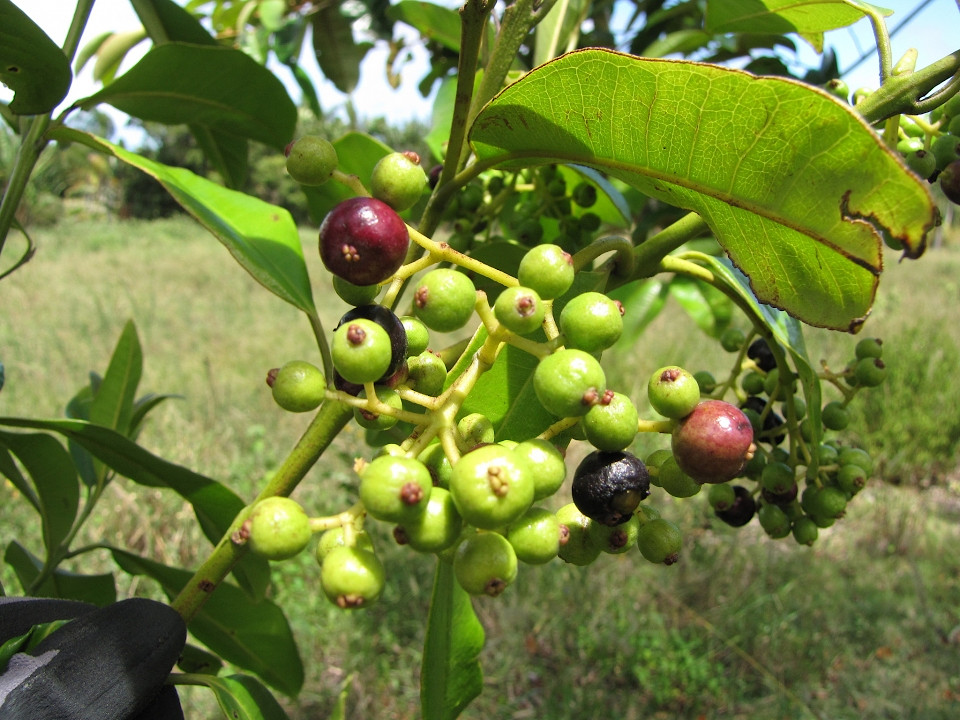Pimenta dioica (L.) Merr. - syn.Pimenta officinalis Lindl.; Pimenta vulgaris Lindl.; Pimenta pimenta (L.) H. Karst.; Myrtus pimenta L. - Myrtaceae
allspice, Jamaica pepper, (Mexican) pimento, clove pepper, Piment, Nelkenpfeffer
Evergreen dioecious tree, 6-15m high; native to Central America, Cuba and Jamaica; bark grey; leaves opposite, simple; flowers white, 0.6cm across; fruits 2-seeded, 5-8mm in diam.
„Allspice is the dried fruit of the P. dioica plant. The fruit are picked when green and unripe and are traditionally dried in the sun. When dry, they are brown and resemble large brown peppercorns. The whole fruit have a longer shelf life than the powdered product and produce a more aromatic product when freshly ground before use.
Fresh leaves are used where available. They are similar in texture to bay leaves and are thus infused during cooking and then removed before serving. Unlike bay leaves, they lose much flavour when dried and stored, so do not figure in commerce. The leaves and wood are often used for smoking meats where allspice is a local crop.“ http://en.wikipedia.org/wiki/Allspice
Methyl eugenol (48.3-67.9%) was the main component of the oil isolated from Mexican pimento berries.
[Comparative study of the oil and supercritical CO2 extract of Mexican pimento (Pimenta dioica Merrill)., García-Fajardo, J., Martínez-Sosa, M., Estarrón-Espinosa, M., Vilarem, G., Gaset, A., de Santos, J.M., Journal of Essential Oil Research, 9(2), 1997, 181-185]
„Leaves of Pimenta dioica were used for supercritical extraction with carbon dioxide to isolate the corresponding volatile concentrate… The main constituent in the extract was eugenol (77.9%).“
[Comparative analysis of supercritical CO2 extract and oil of Pimenta dioica leaves., Marongiu, B., Piras, A., Porcedda, S., Casu, R., Pierucci, P., Journal of Essential Oil Research, Vol.17(5), 2005, 530-532]
Main component of the essential oil of P.dioica fruits is eugenol (86.4%), accompanied by methyl eugenol (3.8%), β-caryophyllene (7.7%), α-humulene (1%) and some limonene (0.18%) and 1,8-cineole (0.10%).
[Nematicidal activity of plant essential oils and components from ajowan (Trachyspermum ammi), allspice (Pimenta dioica) and litsea (Litsea cubeba) essential oils against pine wood nematode (Bursaphelenchus xylophilus). Park, I. K., Kim, J., Lee, S. G., Shin, S. C., Journal of nematology, 39(3), 2007, 275] http://www.ncbi.nlm.nih.gov/pmc/articles/PMC2586506/
„The composition and antioxidant activity of the essential oil obtained through hydrodistillation of pimento berry (Pimenta dioica (L.) Merr) samples, namely P1 and P2, sourced from Jamaica, were studied. … Forty-five constituents were identified. The major compound identified was eugenol (74.71%, 73.35%), followed by methyl eugenol (4.08%, 9.54%) and caryophyllene (4.90%, 3.30%). The antioxidant assays showed that the oils possess very high radical scavenging activities…“
[Composition and antioxidant activity of essential oil of pimento (Pimenta dioica (L) Merr.) from Jamaica., Padmakumari, K. P., Sasidharan, I., Sreekumar, M. M., Natural product research, Vol.25(2), 2011, 152-160]
Main components of the essential oil from the leaves of P.dioica were eugenol (76.0%), methyl eugenol (7.1%), β-caryophyllene (6.4%), α-humulene (1.4%) and α-selinene (1.0%).
[Jirovetz, L., Buchbauer, G., Stoilova, I., Krastanov, A., Stoyanova, A., & Schmidt, E. (2007). Spice plants: chemical composition and antioxidant properties of Pimenta Lindl. essential oils, part 1: Pimenta dioica (L.) Merr. leaf oil from Jamaica. NUTRITION-VIENNA-, 31(2), 55]

Pimenta dioica (L.) Merr. as Pimenta officinalis Lindl.; Köhler,F.E., Medizinal Pflanzen, vol.2 t.174 (1890)
http://plantgenera.org/species.php?id_species=792708

Ripening fruits of Pimenta dioica Useful Tropical Plants Photograph by: Forest and Kim Starr CC BY-SA 2.0
